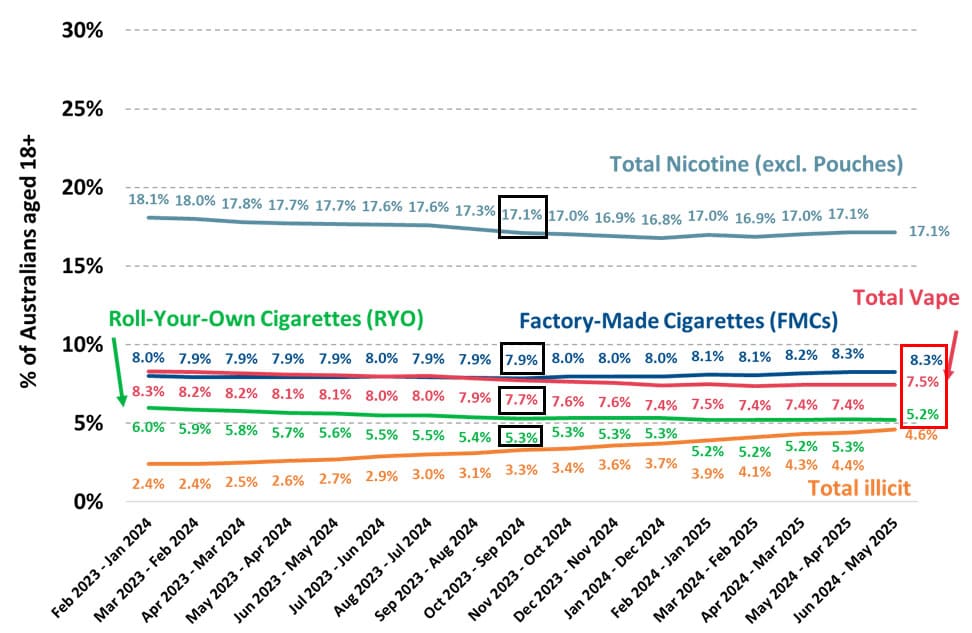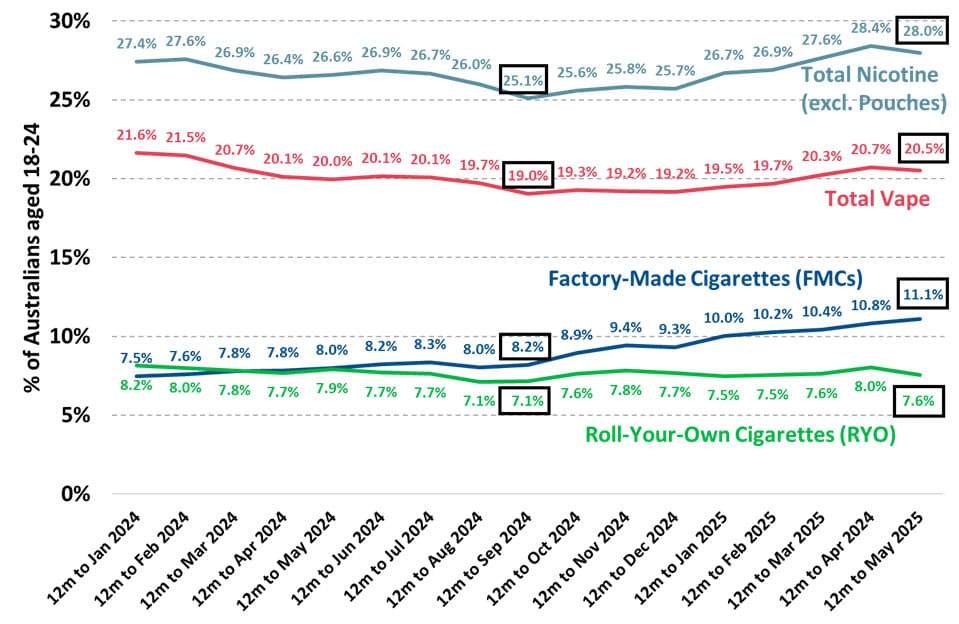To protect young people, Australia implemented a nationwide ban on e-cigarette sales starting July 1, 2024—prohibiting import, domestic production, distribution, commercial possession, and promotion of disposable and non-therapeutic vapes. However, the law had a limited impact on overall e-cigarette usage. At the same time, a black market rapidly emerged, with some products tripling in price. One year after the ban, public health experts noted that cigarette consumption among 18–24-year-olds increased, and overall tobacco use did not decrease. Why did a policy meant to “protect” youth instead drive them back to more harmful smoking habits?
Australia Youth Tobacco Use on the Rise
A recent July report from Australian market research firm Roy Morgan revealed the following trends among 18–24-year-olds in the first year after the ban:
Product
|
Users Before Ban
|
Users After Ban
|
Change
|
Factory-made Cigarettes (FMC)
|
200,000
|
280,000
|
+80,000 (↑2.9%)
|
E-cigarettes
|
470,000
|
510,000
|
+40,000 (↑1.5%)
|
Roll-your-own (RYO)
|
180,000
|
190,000
|
+10,000 (↑0.5%)
|
Total Users (smoking or vaping)
|
620,000
|
700,000
|
+80,000 (↑2.9%)
|
Among all age groups, young adults were the only group where both cigarette and e-cigarette use increased. Nationwide, tobacco use among adults 18 and older rose from 16.8% (approximately 3.59 million people) to 17.1% (approximately 3.70 million), adding around 110,000 users. The main driver of this growth was increased cigarette consumption among young people.

The Domino Effect of a Blanket Ban
Roy Morgan CEO Michele Levine explained, “The policy aimed to protect young people, but a one-size-fits-all approach can have unintended consequences—driving youth back to cigarettes.”
The ban intended to reduce nicotine exposure, but in practice triggered a vicious cycle: ban → black market → low-quality products → return to smoking.
1. Legal channels disappear, black market rises
Unable to purchase e-cigarettes legally, users turned to the black market. Border authorities reported a 300% surge in seized illegal vapes. Nicotine concentrations in these products were unregulated (up to 60 mg/ml), with frequent leaks and harsh throat hits—“poor experiences” discouraged youth from harm reduction.
2. Lack of alternatives undermines quitting motivation
Many young people originally used e-cigarettes as a tool to reduce cigarette intake. The ban blocked these safer alternatives, forcing some back to traditional cigarettes and eroding harm reduction gains.
3. Psychological reactance and social influence
Restrictive measures triggered rebellious curiosity in some young people, while peer networks amplified “trying new things” trends—behavioral patterns that weakened the policy’s intended effect.

Sydney student Karen shared a common experience: “After the ban, e-cigarettes jumped from $15 to $45, and black market products constantly malfunctioned. When the safer option is more expensive and unreliable than cigarettes, I had no choice but to buy them again—even knowing the health risks.”
Similarly, 24-year-old Josh had replaced cigarettes with e-cigarettes for nearly two years. Post-ban, legal products were unavailable, and black market options were costly and unreliable. Within months, he resumed smoking cigarettes: “I know it’s worse for my health, but it’s cheaper and easier to get.”
International Lessons: Restriction Vape ≠ Prohibition
Countries like the UK and New Zealand restrict youth access to e-cigarettes while maintaining legal supply channels for adults, with strict product standards to ensure safety. Data from these markets show that under regulated conditions, e-cigarettes can effectively reduce harm, and cigarette consumption continues to decline.
As a brand with long-standing expertise in vaping technology, SP2S has witnessed the impact of different regulatory approaches across markets. We remain committed to providing adult users with stable, safe, and flavorful products, while exploring sustainable, regulation-compliant solutions that protect youth and support harm reduction for smokers.
Australia’s experience underscores that public health policies must consider long-term behavioral replacement effects, not just short-term goals. Bans without complementary alternatives may push individuals who might have moved away from smoking back into old habits. Effective strategies should combine rational regulation with safe, controllable products, making harm-reducing choices genuinely accessible.



Leave A Comment
Your email address will not be published.